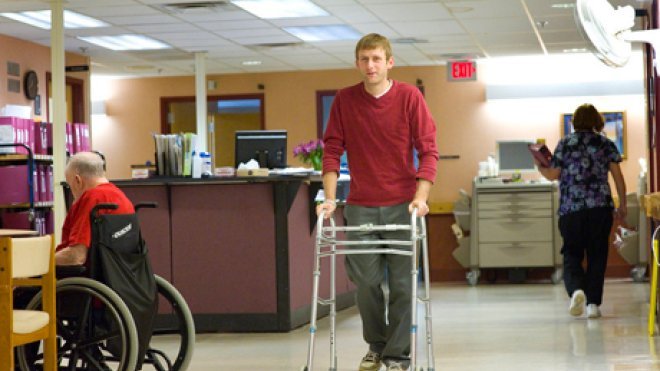For Elders, Designing for Life and Living
Architecture alumnus Evan Carroll '06 on life-long design for elders

PORTLAND, MAINE -- It’s an age-old question that has no easy answer: where should elders live when they can no longer live on their own?
While an array of options from assisted living to nursing homes to retirement communities are available to the aging population in the U.S., elder housing is hardly one-size-fits-all. And Evan Carroll ’06 is dedicating his architecture expertise to the concept of “life-long design” and together with his partner, Sasha Salzberg, launched Bild Architecture – a design firm focused on housing that meets the social needs of community members.
“Life-long design is similar to universal design, but universal design tends to focus a little more on the physical design aspects,” Carroll says. “We look at life-long design as more of a mentality that deals directly with people and the design aspects come second. It’s about finding ways for people who want to live in a particular location to do that – and in our personal experiences, and with most of the people we talk to, that has to do with being direct vicinity of family and close loved ones.”
Like many adult grandchildren, Carroll and Salzberg harbored serious concern as they began their own family and witnessed the challenges their parents faced regarding their aging grandparents. After early research revealed that by 2020 the ratio of working persons to retired persons would be just 2:1, the pair determined a real demographic crisis was emerging in the Portland, Maine, area and they were moved to action. As a nascent firm, they found a niche:
“We wanted people to identify us with something that was wholesome and community-oriented,” Carroll says. “We decided to go in this direction to try to understand the issues of long term care – to really study and pursue it.”
So Carroll attended a conference for elder care providers at the University of New England, and quickly enrolled as a participant in the UNE Learning by Living nursing home immersion program for medical students, intended to provide care providers a more comprehensive and holistic perspective of their patients to better meet their needs. If it could work for doctors, Carroll thought, why not architects?
He spent a week living in the Maine Veterans Home memory care unit, navigating the space in a wheelchair and with a walker to better understand the physical limitations and needs of the built environment as well as the staff who care for the elders who live there.
“Our approach is unique in the sense that a lot of firms that do design in this area are focusing on a specific building type – a nursing home or an assisted living facility,” Salzberg notes. “We want to understand the staff needs, policy, funding – anything that will be helpful to get the design right.”
Unanticipated insights emerged from the home stay, Carroll notes, including factors of vision. Designers may want to include an interesting pattern on the floor or carpet, but that design element could pose a problem for a resident with limited vision. For instance, if the floor is black and white checkered tile, a person with Alzheimer’s and visual impairment may perceive the white tiles as holes in the floor.
Such finish details – such as floors that won’t make an elder feel like they are falling – certainly matter, Carroll says, but must be combined with operational needs and architectural design elements so that elders transitioning to new models of living can customize their living space as much as possible.
“That’s how you bridge the gap completely,” he says. “Even if it looks residential, if people can’t customize it, it still feels like a hotel.”
Some solutions he’s found successful, particularly in Alzheimer’s care facilities he’s worked on, include window dressings, walls strong enough to hold pictures – even custom-built shadow boxes to house personal memorabilia and help identify the room.
“A lot of the solutions we find aren’t necessarily architectural,” he says, “but we will find them.”
And for those elders who aren’t in need of living assistance, Carroll says social structure and convenient amenities are the keys to sustained and safe independent living.
“My own personal interest in design is creating housing that cuts off isolation at the pass – housing in urban settings where you can get out of your house and get somewhere without a license, go to the corner store and pick up the paper and your neighbor expects to see you,” Carroll says. “It is the difference between being able to live independently or not.”